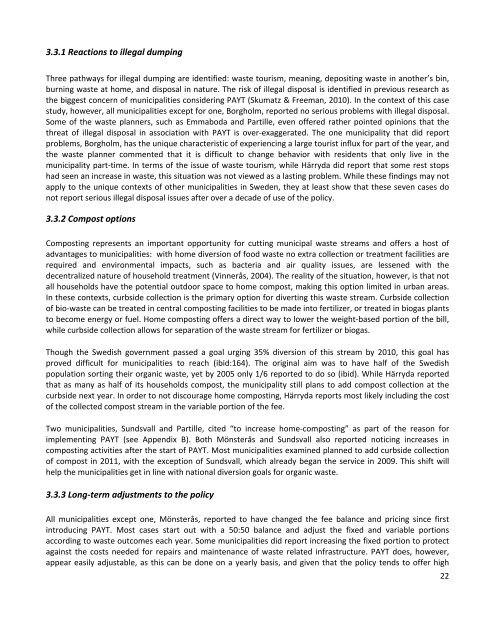Waste prevention and Pay as You Throw, a collective case ... - lumes
Waste prevention and Pay as You Throw, a collective case ... - lumes
Waste prevention and Pay as You Throw, a collective case ... - lumes
You also want an ePaper? Increase the reach of your titles
YUMPU automatically turns print PDFs into web optimized ePapers that Google loves.
3.3.1 Reactions to illegal dumping<br />
Three pathways for illegal dumping are identified: w<strong>as</strong>te tourism, meaning, depositing w<strong>as</strong>te in another’s bin,<br />
burning w<strong>as</strong>te at home, <strong>and</strong> disposal in nature. The risk of illegal disposal is identified in previous research <strong>as</strong><br />
the biggest concern of municipalities considering PAYT (Skumatz & Freeman, 2010). In the context of this c<strong>as</strong>e<br />
study, however, all municipalities except for one, Borgholm, reported no serious problems with illegal disposal.<br />
Some of the w<strong>as</strong>te planners, such <strong>as</strong> Emmaboda <strong>and</strong> Partille, even offered rather pointed opinions that the<br />
threat of illegal disposal in <strong>as</strong>sociation with PAYT is over‐exaggerated. The one municipality that did report<br />
problems, Borgholm, h<strong>as</strong> the unique characteristic of experiencing a large tourist influx for part of the year, <strong>and</strong><br />
the w<strong>as</strong>te planner commented that it is difficult to change behavior with residents that only live in the<br />
municipality part‐time. In terms of the issue of w<strong>as</strong>te tourism, while Härryda did report that some rest stops<br />
had seen an incre<strong>as</strong>e in w<strong>as</strong>te, this situation w<strong>as</strong> not viewed <strong>as</strong> a l<strong>as</strong>ting problem. While these findings may not<br />
apply to the unique contexts of other municipalities in Sweden, they at le<strong>as</strong>t show that these seven c<strong>as</strong>es do<br />
not report serious illegal disposal issues after over a decade of use of the policy.<br />
3.3.2 Compost options<br />
Composting represents an important opportunity for cutting municipal w<strong>as</strong>te streams <strong>and</strong> offers a host of<br />
advantages to municipalities: with home diversion of food w<strong>as</strong>te no extra collection or treatment facilities are<br />
required <strong>and</strong> environmental impacts, such <strong>as</strong> bacteria <strong>and</strong> air quality issues, are lessened with the<br />
decentralized nature of household treatment (Vinnerås, 2004). The reality of the situation, however, is that not<br />
all households have the potential outdoor space to home compost, making this option limited in urban are<strong>as</strong>.<br />
In these contexts, curbside collection is the primary option for diverting this w<strong>as</strong>te stream. Curbside collection<br />
of bio‐w<strong>as</strong>te can be treated in central composting facilities to be made into fertilizer, or treated in biog<strong>as</strong> plants<br />
to become energy or fuel. Home composting offers a direct way to lower the weight‐b<strong>as</strong>ed portion of the bill,<br />
while curbside collection allows for separation of the w<strong>as</strong>te stream for fertilizer or biog<strong>as</strong>.<br />
Though the Swedish government p<strong>as</strong>sed a goal urging 35% diversion of this stream by 2010, this goal h<strong>as</strong><br />
proved difficult for municipalities to reach (ibid:164). The original aim w<strong>as</strong> to have half of the Swedish<br />
population sorting their organic w<strong>as</strong>te, yet by 2005 only 1/6 reported to do so (ibid). While Härryda reported<br />
that <strong>as</strong> many <strong>as</strong> half of its households compost, the municipality still plans to add compost collection at the<br />
curbside next year. In order to not discourage home composting, Härryda reports most likely including the cost<br />
of the collected compost stream in the variable portion of the fee.<br />
Two municipalities, Sundsvall <strong>and</strong> Partille, cited “to incre<strong>as</strong>e home‐composting” <strong>as</strong> part of the re<strong>as</strong>on for<br />
implementing PAYT (see Appendix B). Both Mönsterås <strong>and</strong> Sundsvall also reported noticing incre<strong>as</strong>es in<br />
composting activities after the start of PAYT. Most municipalities examined planned to add curbside collection<br />
of compost in 2011, with the exception of Sundsvall, which already began the service in 2009. This shift will<br />
help the municipalities get in line with national diversion goals for organic w<strong>as</strong>te.<br />
3.3.3 Long‐term adjustments to the policy<br />
All municipalities except one, Mönsterås, reported to have changed the fee balance <strong>and</strong> pricing since first<br />
introducing PAYT. Most c<strong>as</strong>es start out with a 50:50 balance <strong>and</strong> adjust the fixed <strong>and</strong> variable portions<br />
according to w<strong>as</strong>te outcomes each year. Some municipalities did report incre<strong>as</strong>ing the fixed portion to protect<br />
against the costs needed for repairs <strong>and</strong> maintenance of w<strong>as</strong>te related infr<strong>as</strong>tructure. PAYT does, however,<br />
appear e<strong>as</strong>ily adjustable, <strong>as</strong> this can be done on a yearly b<strong>as</strong>is, <strong>and</strong> given that the policy tends to offer high<br />
22
















